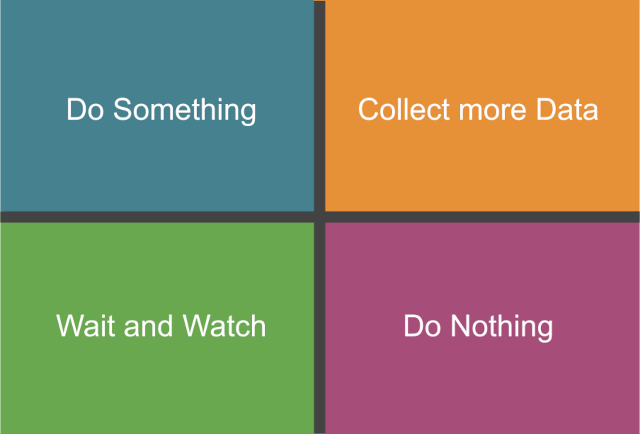To do something or nothing, that is the question.
As leaders, we are continually making decisions, deciding to and taking action on situations as they arise: What technology should the team use? Should I performance manage a report? Deciding what and when to do something is often one of the most critical choices we make: too late or too early will have ramifications.
While it is important to act, and we as leaders should have a bias for action, it is sometimes prudent not to. I believe taking a moment, even if just a minute to decide whether to act before doing so is critical. In this post, I’ll detail my approach to making this determination going over the four different buckets that I place each situation into.

Do Something
The most known and often exploited quadrant is do something. Any situation in this bucket can be regarded as one that requires you to take an action to resolve. When you decide to do something, the first thing to figure out is exactly what you are going to do with the expectation, that you will take this action. This could be to schedule a cross team meeting or to communicate a new process to your team. Items in this quadrant are often pretty clear based on answering:
- What is the impact of not doing anything?
- Does the situation get worse if I wait till tomorrow, next week, etc?
- Is it clear what must be done to remedy the situation?
- Are there company procedures to deal with the situation? What do they say?
Collect more Data
In this quadrant, your assessment of the situation is that it is important. However, you are not yet confident enough to take any action because there are pieces of the picture you are missing. Instead, you decide to either figure a way to or to get additional information on the situation in order to take action. For example, requesting metrics from a team member or reaching out to colleagues on other teams to understand how they are handling the situation. With this information in hand, you should be able to decide whether you will do something or do nothing. Ask yourself:
- Do I know how to remedy this situation?
- Do I know everything I need to know to take action? Am I confident or worried about taking the action?
- Should it be addressed urgently or can it wait for some time?
- Is there someone who may know more about this situation?
Wait and Watch
Wait and watch, similar to collect more data is a situation that you deem important but not important enough. It is something that you think you should get round to addressing but can wait. You keep watching the situation and reassessing in case its importance changes and it needs to move to another quadrant. From a prioritization standpoint, these are akin to important but not urgent. Ponder these questions for this quadrant:
- How long can I wait until the situation becomes damaging?
- Will doing anything right now make things worse?
Do Nothing
These are scenarios that you deem as requiring no action on your part. They are quickly forgotten about unless they resurface. Sometimes, items in do nothing are actionable but are intentional left undone in order to coach others or to test the team’s boundaries. To decide if to do nothing, ask yourself these questions:
- Do I have the time to do this? What happens if I don’t do anything?
- Is there someone else that can do it? Should I ask them to or leave it and see if they step up?
- How low is this on the priority list? Will I realistically ever get to it?
Any given situation will move between these quadrants until it gets to a final state of either do something or do nothing and should be reassessed as new information comes to light.